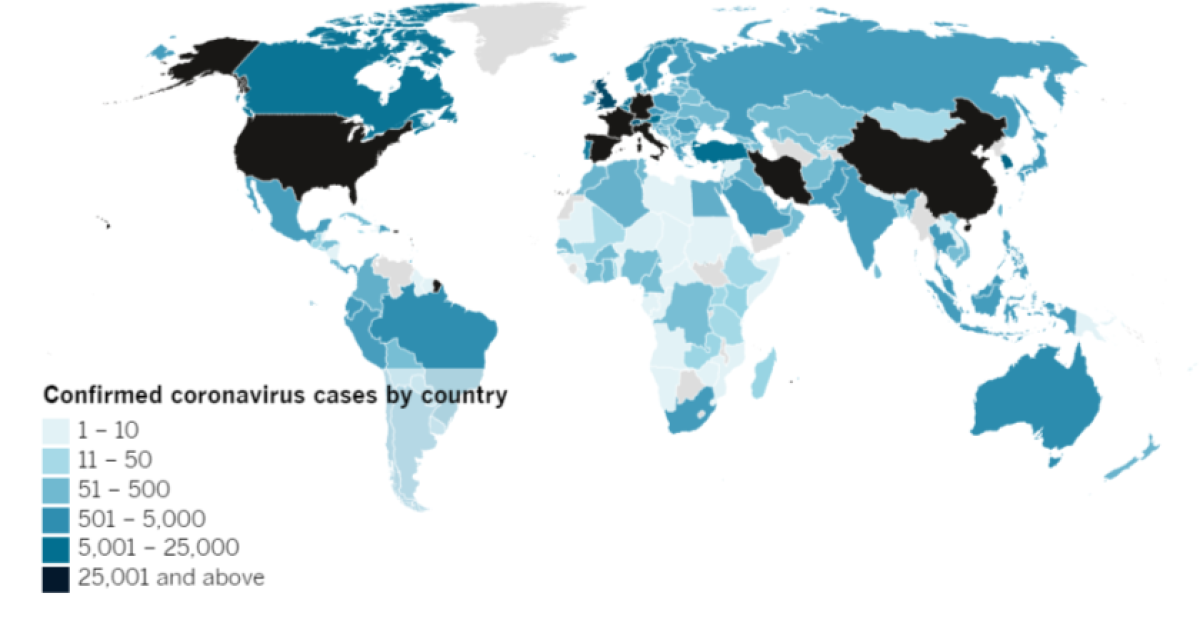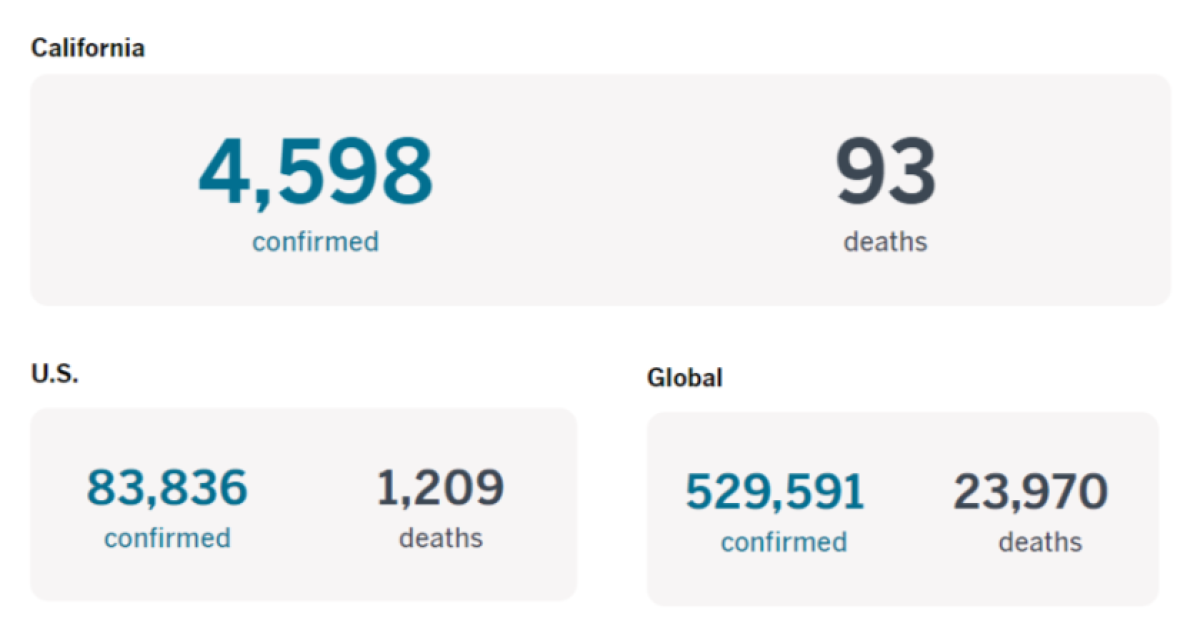Coronavirus Today: Beaches and trails close
- Share via
Good evening. I’m Diya Chacko, and it’s Friday, March 27. Here’s what’s happening with the coronavirus outbreak.
All Los Angeles County trails and beaches are now off-limits, thanks to the crowds who last weekend swarmed the sand, hiking trails and parks without following social-distancing guidelines. The county even sent out a mass public safety alert Friday evening to tell people to stay away: “Beaches and trails are now closed. Do your part to slow the spread of this deadly disease.”
The order, which warns that violations are a misdemeanor offense punishable by fines and/or imprisonment, also applies to beach bike paths, bathrooms, piers and promenades.
The ban will hurt for Angelenos, who tend to maintain intimate relationships with their environment, writes Daniel Hernandez in a first-person column about the meaning of public spaces. “Being outside is how we make life happen as Southern Californians,” he writes. “Our instincts take us to fresher air, in good and in ill.”
But stopping the spread of the coronavirus should be our top priority, said County Supervisor Janice Hahn. “I understand that this is a huge sacrifice for everyone who enjoys going to our beaches. But we cannot risk another sunny weekend with crowds at the beach spreading this virus.”
Gov. Gavin Newsom on Friday announced a temporary statewide ban on evictions through May for California renters who are sick, have to care for sick family or lost work because of the pandemic. The measure, which protects tenants who can’t pay rent through May 31, is stronger than prior action the governor had taken. But renters must notify their landlords in writing within seven days of their nonpayment and must still eventually pay all the rent they owe.
The move is intended to keep people in their homes at a time when tens of thousands of homeless Californians are still living on the streets, in a crisis that threatens to make shortages of hospital beds and ventilators even more acute. A new study estimates that nearly 2,600 homeless people in the Los Angeles area alone will need to be hospitalized for COVID-19, and about 900 of them will require intensive care. Already, they’re at a higher risk for developing severe forms of the disease.
Also Friday, President Trump signed a $2-trillion economic relief package just hours after the House approved it by a voice vote. It’s the largest rescue measure in U.S. history, and in addition to providing for direct payments and expanding unemployment insurance, it will let Americans draw on the money in their 401(k)s and other tax-deferred accounts without incurring penalties. Rules on 401(k) loans will also be relaxed, and some retirees will be able to avoid minimum distribution rules. The plan expands on what’s been done for retirement savers after previous disasters such as California wildfires.
What to do this weekend
Practice social distancing by spending the weekend at home. Here are some ideas for entertainment:
Set up virtual get-togethers with your friends. If you can set up a Skype call or a Google Hangout, you can do happy hour, sing karaoke, have a game night, host a watch party or meet with a book club. We’ve got technical instructions here, plus more ideas for stuff to do. Everyone’s itching for human contact, and this is the next best thing.
Work out at home. When was the last time you stretched? Try a yoga video (“Yoga With Adriene” is great for beginners and vinyasa regulars alike), download the Peloton app (now free for 90 days, with workouts ranging from cycling to yoga) or search YouTube for whatever kind of class you normally take at the gym.
Get closer to nature. Even under the new state and local orders, you’re allowed to go out for a walk, run or bike ride — provided you stay six feet away from everyone else. Beaches and hiking trails are off-limits, though.
Learn to cook by watching this new video series from the L.A. Times Food team. They also have a Food coloring book.
Expand your movie list. Film critic Justin Chang recommends some light-hearted comedies in the latest episode of our podcast “The Reel,” and writer Mark Olsen suggests these new streaming films in his Indie Focus newsletter.
Plus, here are lists of the 50 best TV shows to binge, 11 TV shows to occupy your kids, 10 free L.A. Times podcasts to listen to, 100 ideas for activities and the ultimate Times entertainment guide to staying at home.
By the numbers
Cases as of 4 p.m. PDT Friday:
Track the latest numbers and how they break down by county and state with our graphics.
Where is the coronavirus spreading?

Your support helps us deliver the news that matters most.
Across California
The Navy’s Mercy hospital ship has now arrived at the Port of Los Angeles to assist with an expected surge in COVID-19 patients. The ship, which has a capacity of 1,000 beds, will house patients without COVID-19 in order to free up regional hospital beds for those who have it.
The fragile rebirth of the town of Paradise, which was almost completely destroyed by the 2018 Camp fire, is being tested by the pandemic. “We are still deep, deep in recovery from the fire. We’re still in emergency mode,” a town spokeswoman said. “We considered that an unprecedented disaster, and now we have another unprecedented disaster? ... It’s like, really, when are the locusts showing up?”
Companies that rent or sell RVs, camper vans and motor coaches are adapting to a veritable wartime economy as tourism dries up. Many are providing RVs for medical personnel and other essential workers who require lodging that keeps them away from home, where they could pick up COVID-19 or spread it to others. Others are seeing an uptick in rentals from customers who don’t want to fly but still need to travel.
In places with huge Mexican American populations like L.A., quinceañeras are part of the cultural lifeblood of the city. Now, like prom and graduation, they’re another coming-of-age ritual lost to the pandemic.
A decade ago, California kept a massive emergency medical reserve of ventilators and respirators, along with several mobile acute care hospitals, that would have been vital to fighting the coronavirus outbreak. But after the 2008 recession, state leaders cut funding to maintain the supplies, and the stockpile dwindled. The emergency programs were never restored after the economy rebounded.
How to stay safe
— Wash your hands for at least 20 seconds! Here’s a super-fun how-to video.
— Stop touching your face, and keep your phone clean.
— Watch for symptoms including fever, cough and shortness of breath (and possibly the loss of smell or taste). If you’re worried you might be infected, call your doctor or urgent care clinic before going.
— Practice social distancing, such as maintaining a six-foot radius of personal space in public.
— Only wear a mask if circumstances warrant it, for instance if you must be in close contact with people in public.
— Here’s how to care for someone with COVID-19, from monitoring their symptoms to preventing the virus’ spread.
How to stay sane
— Was your job affected by coronavirus? Here’s how to file for unemployment.
— Here are all the ways to stay virtually connected with your friends.
— Need groceries? Here’s how to stock up for staying home. You can also watch our video guide on YouTube.
— Visit our free games and puzzles page for daily crosswords, card games, arcade games and more.
— Here are some free resources for restaurant workers and entertainment industry professionals having trouble making ends meet.
— Advice for helping kids navigate pandemic life includes being honest about uncertainties, acknowledging their feelings and sticking to a routine. Here’s guidance from the CDC.
— The L.A. Times Book Club will meet virtually beginning Monday and chat with L.A. noir authors. For more information, sign up for its newsletter.
Around the nation and the world
The Trump administration hasn’t outlined a plan for getting and distributing medical supplies in an emergency. In addition, cross-border trade restrictions are complicating efforts to bring critical supplies to hospitals, as a Texas doctor and his golfing friend learned in their desperate scramble to get 525,000 masks across the border from Mexico. “We joked that we felt like drug runners, except we weren’t making a dime,” said one of the men involved.
With the federal government leaving much of the decision-making to the states, state leaders like Newsom and New York Gov. Andrew Cuomo are filling a vacuum. In the process, their political profiles have grown exponentially across the country as their demands for action, pleas for aid and calls for shared sacrifice define the Democratic response to the pandemic. They have become the opposition party’s foil to Trump.
Two of New York City’s leading hospital systems this week announced stringent new policies barring visitors of any kind to its labor and postpartum units. As a result, thousands of pregnant women learned they would have to give birth without anyone in attendance apart from hospital staff: no partner, no doula, no family member.
In Spain, the countryside presents unique challenges to fighting the spread of the disease among rural communities. A group of farmers is driving tractors loaded with disinfectant through villages and small towns. More people with backpacks loaded with liquid disinfectant are sent where tractors cannot reach. All are volunteers.
Even before the virus appeared, social distancing was becoming a way of life in South Korea as people became accustomed to same-day shipping, on-demand service apps and an abundance of streamed entertainment. In forcing a swath of humanity to shelter in place for weeks on end, the pandemic may very well accelerate that digital sequestration, writes Seoul correspondent Victoria Kim in a first-person account.
Your questions answered
Today’s reader question comes from Eddie Shiojima, who wants to know: Is the government helping with paid sick leave during the coronavirus outbreak? Business reporter James F. Peltz breaks it down.
Whether you are guaranteed paid sick leave depends on where and how you work.
A new federal law expands paid sick leave during the coronavirus crisis for many employees, including those who have COVID-19, are subject to quarantine or have been advised to self-quarantine or are caring either for family members with COVID-19 or for children whose schools or daycare centers have closed.
Under the law, eligible full-time workers can get up to two weeks of paid leave, and part-time workers can get a period of leave equal to the number of hours they work on average over a two-week period. Firms paying the sick leave will be reimbursed with federal tax credits.
However, the federal law excludes companies that employ more than 500 people. It also gives the Department of Labor the authority to exempt firms that employ healthcare workers and emergency responders, as well as to let small businesses with fewer than 50 workers opt out of paying sick leave if the company thinks that could drive it out of business.
In California, state law already provides full- and part-time workers at least three days of paid sick leave each year. Workers in Los Angeles are eligible for at least six.
Got a question? Our reporters covering the coronavirus outbreak want to hear from you. Email us your questions, and we’ll do our best to answer them. You can find answers to other common questions in our morning and midday roundup.
For the most up-to-date coronavirus coverage from The Times, visit our live updates page, visit our Health section and follow us on Twitter and on Instagram.





